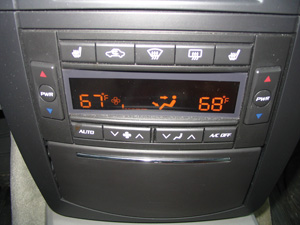The air conditioning compressor pressurizes and circulates refrigerant through the refrigeration circuit. On most vehicles, the compressor is belt-driven via a magnetic clutch on the compressor input shaft. On some hybrids, the compressor may be electrically driven. The compressor usually cycles on and off to regulate the flow of refrigerant, but on some
vehicles a variable displacement compressor that runs continuously is used to vary refrigerant flow.
 Compressor failures can occur as a result of low refrigerant, the wrong refrigerant, loss of compressor oil or the wrong compressor oil, or refrigerant contamination. If a compressor has failed, the condenser should be flushed to remove contaminants or be replaced. A new orifice tube is also recommended.
Compressor failures can occur as a result of low refrigerant, the wrong refrigerant, loss of compressor oil or the wrong compressor oil, or refrigerant contamination. If a compressor has failed, the condenser should be flushed to remove contaminants or be replaced. A new orifice tube is also recommended.
Different types of compressors require specific types of oil. Older R12 A/C systems require mineral oil, while newer R134a systems use mostly PAG oil. Older R12 systems that have been retrofitted to R12 can use POE oil or PAG oil as specified by the compressor manufacturer.
Replacement compressors may contain the proper lubricant for the vehicle application, but some may contain a temporary shipping oil that must be drained out prior to installation. Others are shipped dry. Refer to the vehicle specifications for the type and amount of compressor oil that is required for the system.
In the refrigeration circuit, high-pressure refrigerant vapor flows from the compressor to the condenser (which is usually mounted in front of the radiator). Airflow through the condenser cools the refrigerant, causing it to condense and change into a liquid. The condenser may have its own cooling fan to increase airflow when the A/C is running, or it may share the radiator fan.
From the condenser, the liquid high-pressure refrigerant flows through a hose to the orifice tube or expansion valve, which meters flow into the evaporator (which is usually located inside the HVAC housing under the dash). Inside the evaporator, the refrigerant absorbs heat, evaporates and chills the air flowing into the passenger compartment. The refrigerant vapor is then pulled back to the compressor to repeat the process over and over again.
A condenser may have to be replaced if it is leaking, damaged or contaminated with sludge or internal debris. An evaporator may have to be replaced if it is leaking as a result of internal corrosion. Evaporators can require a lot of labor to replace because of their buried location inside the HVAC unit.
The accumulator or receiver/drier is a device that serves as a refrigerant reservoir and a system filter. It contains a bag of moisture-absorbing crystals called desiccant. Moisture in an A/C system can cause acids and sludge. A new accumulator or receiver/drier should be installed if the compressor, condenser or evaporator are being replaced, or if the system has been open and exposed to air for more than a day.
A new orifice tube should also be installed following a compressor failure, or if the system is contaminated with sludge. Aftermarket “variable displacement” orifice tubes can improve low-speed cooling on older vehicles that have been retrofitted to R134a. Some newer vehicles have variable orifice tubes from the factory.
Other parts that may need to be replaced include hoses, O-rings and seals. The “suction hose” is located between evaporator and condenser. The “high-pressure hose” is located between compressor and condenser. Newer vehicles with R134a A/C systems all require nylon-lined “barrier” style hoses with preformed end fittings. Older vehicles that are being retrofitted to R134a usually don’t need new hoses (unless one is leaking), but some of the O-rings may have to be replaced with ones that are R134a-compatible.
Many A/C systems have a low-pressure cutout switch to protect the compressor if a leak should allow the
refrigerant to be lost. When pressure drops below a certain point, the switch prevents the compressor clutch from engaging. Many systems also have a high-pressure cutout switch that turns the compressor off if pressure gets too high (which can occur during extremely high-load, high-temperature conditions).
R12 (Freon) refrigerant is mostly history now, having been replaced by R134a since 1994. The two different refrigerants should not be intermixed. If an older vehicle requires major A/C repairs, it can usually be retrofitted to R134a. Only certified professionals can purchase R12 legally but anyone can purchase R134a. Other alternative refrigerants are available for retrofitting older R12 A/C systems, but these should not be used in newer R134a A/C systems. General Motors will be using the new refrigerant, called HFO-1234yf, in 2013 Chevrolet, Buick, GMC and Cadillac models in the U.S.
This new refrigerant will gradually replace R134a in most new vehicles due to its lower global warming potential rating. The heater is also part of the HVAC system, and is uses hot engine coolant to heat air entering the passenger compartment. The output temperature of the HVAC system (hot or cold) depends on engine coolant temperature and how the air is routed through the HVAC unit (through the heater core for heat, through the evaporator for cooling, or through both for various temperature settings in between). Blend air control doors inside the HVAC unit regulate air temperature depending on the driver’s input. In defrost mode, the air is both chilled (to remove moisture) and heated to speed defrosting of the windshield.
Other parts that affect the operation of the A/C and heating system include the heater blower motor, heater control valve (restricts coolant flow to the heater core), radiator/condenser cooling fan(s), and automatic temperature control system.
One other item that may need to be replaced on newer vehicles is the cabin air filter. The filter is usually located behind the glove box or at the base of the windshield. A new filter every 15,000 miles is often recommended.













